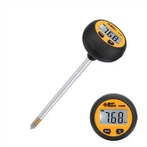Can the 9V battery used in the multimeter and process calibrator be replaced by a 1.5V battery boosted to 9V?
The operating current of multimeters and process calibrators is generally not large, and the operating current of ordinary digital multimeters is mostly below 20mA, so it is completely possible to use 1.5V dry batteries (or 1.2V Ni-MH batteries) to boost the voltage through the booster circuit. voltage to replace the 9V laminated battery. The following introduces a simple and easy-to-make 1.5V to 9V voltage regulator circuit, which can replace the 9V laminated battery used in the multimeter.
In the circuit, the triode 9013 and 8550 form a complementary self-excited multivibrator, and the two tubes work in the switch state. T is a step-up transformer, and its primary coil is used as the collector load of the 8550 triode. After the oscillating signal output by the collector of the 8550 is boosted by the transformer T, a high-frequency AC voltage is generated in its secondary, and the voltage is rectified by the Schottky diode 1N5819 , C2 filtering and voltage regulator VD2, the output at the Vout terminal is a stable 9V voltage.
The oscillation frequency of this circuit is mainly determined by R2 and C1. Generally, the oscillation frequency can be selected from 5 to 20KHz. The output voltage of the boost circuit is determined by the voltage regulation value of the regulator tube VD2. If you need a stable voltage of 9V, you can use a 1N4739 voltage regulator tube with a voltage regulation value of 9.1V and a power of 1W. Since the secondary output of the transformer is a high-frequency AC voltage, VD1 should use a switching diode or a Schottky diode with good high-frequency performance. Capacitor C2 is preferably a tantalum capacitor with good high-frequency filtering. The size of R3 depends on the voltage across C2 and the actual working current of the multimeter. Assume here that the voltage across C2 is 15V, the current flowing through VD2 is 10mA, and the maximum operating current of the multimeter is 15mA, then R3 can be 240Ω.
ferrite ring.
The step-up transformer of this circuit can be made of ferrite magnetic surround. The number of turns and wire diameter of the primary coil and secondary coil are shown in Figure 1. The ferrite magnetic ring can be removed from some old electronic ballasts or switching power supplies.
When making, the β of the two triodes should be as large as possible. The power switch S in the circuit can use the power switch of the original multimeter. This circuit can use a No. 5 dry battery or a 1.2V Ni-MH battery as a power source.






